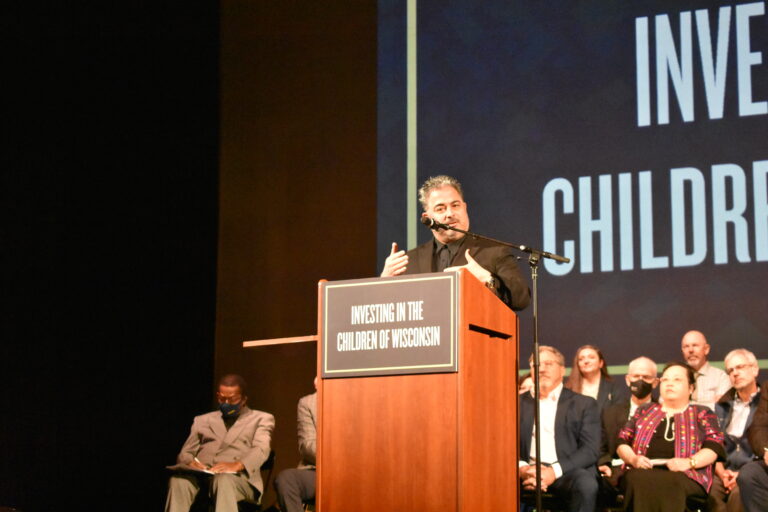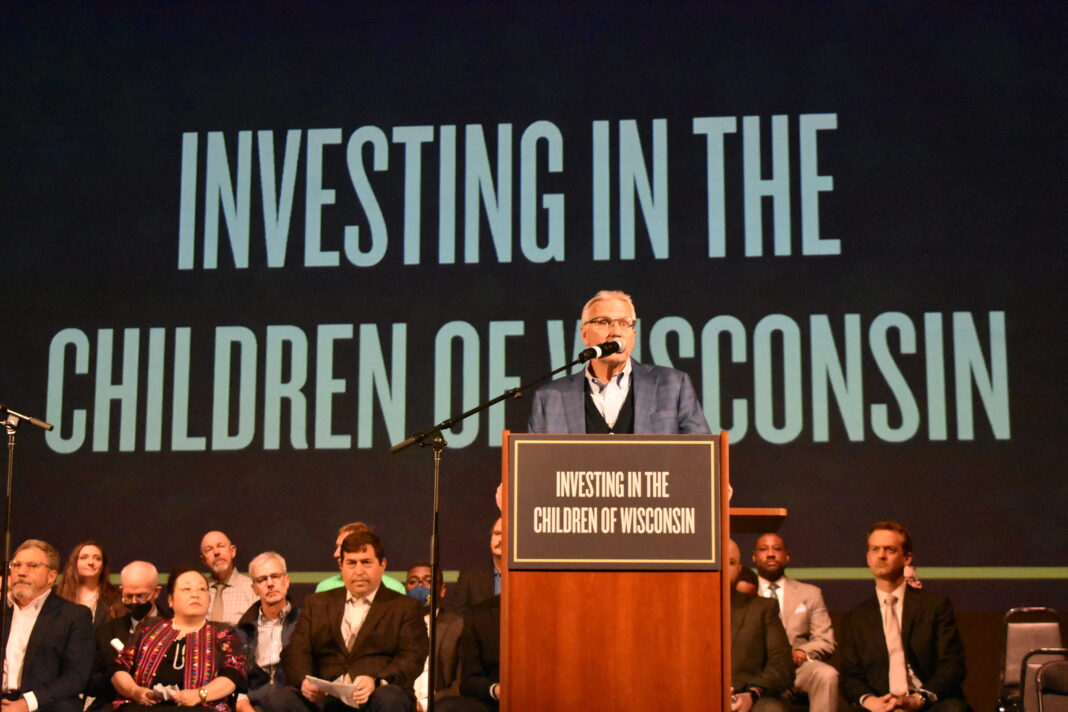Some Milwaukee business and education leaders are asking Gov. Tony Evers and state lawmakers to dedicate a portion of the state’s projected surplus to increase funding for Wisconsin’s K-12 schools.
More than two dozen Milwaukee-area leaders attended a press conference at the Riverside Theater Wednesday morning, where they made the case for an inflationary adjustment of $343 more per student and raising the state’s reimbursement rate for students with disabilities, from the current rate of 28% to 50%. Those increases would be applied to all public districts, independent charter schools, and private schools that receive publicly funded vouchers.
Combined, the initiatives would cost an estimated $700 million, which leaders argued is reasonable in light of the state’s projected $5.5 billion surplus.
The coalition, which wrote a letter that has netted over 350 signatures, is noteworthy for its representation of both business leaders as well as those from Milwaukee’s three school sectors who ordinarily find themselves at odds in discussions about school funding.

John Kersey, executive vice president of Zilber Ltd and president of the MPS Foundation board, said the effort represents a setting aside of differences among school sectors to “advocate for something that would benefit all of our kids.”
Milwaukee Bucks president Peter Feigin, Metropolitan Milwaukee Association of Commerce president Tim Sheehy, Kapco Metal Stamping chief executive officer Sean Cummings, and Palermo Villa Inc. CEO Giacomo Fallucca were among those representing the private sector.
“It’s about doing the right thing. And doing the right thing means investing,” Fallucca said. “… When I think about the surplus dollars that we will have and the amount that’s going to be allocated, what are the other plans? And if we could list the top 10 things, wouldn’t our children, education and all that goes with it, wouldn’t that be, like, number one?”
This school year, state-imposed revenue limits for schools remained flat, following per-pupil increases of $175 and $179 the previous two years.
Revenue limits are designed to restrict the amount of revenue a school district can raise through local property taxes and state aid. Revenue limits vary from district to district, based on their enrollment. MPS’s per-student revenue limit in 2020-’21 was $10,476, compared to the state average of $11,450. That figure doesn’t include the amount public school districts also receive in state categorical and federal aids. The proposed $343 increase in per-pupil revenue limit would go into effect in the fall.
School and business leaders are also seeking an increase in funding for students with disabilities. Currently, about one-fourth of eligible expenses are reimbursed, which is one of the lowest reimbursement rates in the country. To make up the gap, district leaders say they are forced to redirect money from general education funds intended to meet the needs of all students.
In addition to MPS, several other public school districts signed the letter, including South Milwaukee, Greendale, Kenosha Unified, Madison Metropolitan, Green Bay Area and several rural districts. A similar press conference was also held with Madison leaders on Wednesday.
Although districts received federal emergency relief during the pandemic, school leaders noted that those funds were earmarked for pandemic-related learning loss and recovery efforts. The School District of South Milwaukee, for example, directed relief funds to HVAC improvements, nursing services and other mitigation efforts, said Blaise Paul, director of business services.
“That was exactly what that type of funding was meant for. It’s one-time federal funding with a one-time expenditure match,” Paul said.
But now many schools are struggling to cover ongoing costs, such as maintaining programming and retaining teachers, amid rising inflation. South Milwaukee School District faces a $1 million deficit, Paul said.
He likened COVID-19 to a hailstorm.
“It did great damage to our roofs as a hailstorm. The federal government came in with an insurance check. That insurance check was meant to fix the roof. Unfortunately, there’s been a lot of pressure (saying) ‘Don’t worry about using that insurance check to fix the roof. Use it to pay the mortgage,’” Paul said.
While the focus of Wednesday’s press conference was on increasing per-pupil and special education funding across all schools, Sheehy raised concerns with the particular disparity in funding among Milwaukee’s school sectors. Private voucher and charters schools in Milwaukee receive roughly 36-46% less per student than their MPS counterparts. MMAC has been vocal in advocating for funding parity among those sectors.

“Increased per-pupil funding is one of the few existing ways to support all students in the city,” Sheehy said. “Giving parents choice and then inequitably funding that choice creates a system where we have second-class students.”
Joel Brennan, who recently took over as executive director of the Greater Milwaukee Committee after working for two years as secretary of the Wisconsin Department of Administration, said the state is in the enviable position to have a projected $3.8 billion surplus at the end of the 2021-’23 biennium in addition to the $1.7 billion already in the state’s rainy-day fund.
“The state has the money,” Brennan said. “Don’t let anybody tell you that the state does not have the money.”


